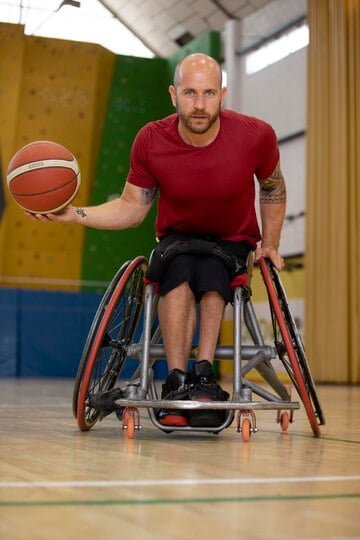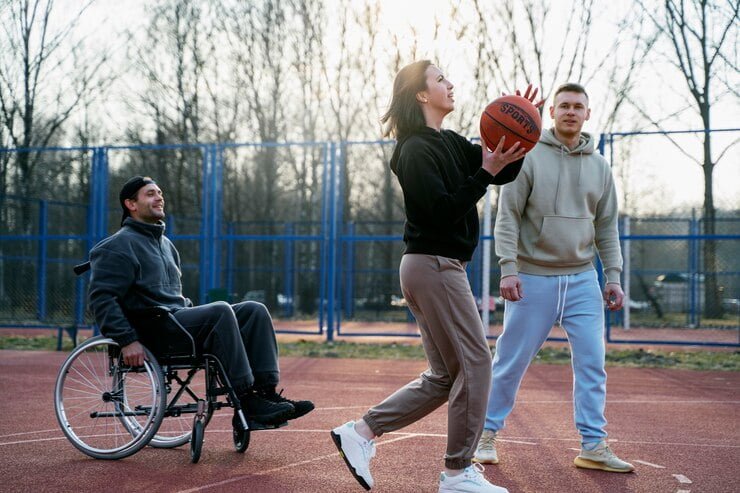
Physical and psychological well-being are maintained by an active lifestyle regardless of age or mobility constraints. For older adults, regular exercises can improve strength, flexibility and overall well being. This blog post will look into different wheelchair exercises designed for seniors; it will provide comprehensive instructions to caregivers using detailed descriptions.
Why Wheelchair Users Should Exercise
Exercise has many benefits for elderly people who use wheelchairs:
Better Cardiovascular Health:
Physical activities performed regularly help keep the heart healthy and decrease the risk of any cardiovascular disease.
Muscle Strength:
Stronger muscles enable better movement and ability to perform daily tasks independently.
Enhanced Mental Health:
Exercise releases endorphins that make one feel good and reduce incidences of depression and anxiety.
Flexibility Increase:
Stretches maintain joints’ flexibility preventing stiffness or discomfort.
Improved Circulation:
Movement improves blood flow which is important for general health.
Various kinds of Wheelchair Exercises
Upper Body Strengthening
Seated Push-Ups
Instructions:
Sit comfortably on the wheelchair.
Rest your hands on the armrests – these are arm supports fitted at each side of a wheelchair seat.
Push yourself up with your hands, lifting your buttocks slightly off the seat.
Hold this position for about 5 seconds before gradually lowering yourself back down again
Repeat these movements around 10-15 times in each set

Benefits:
This strengthens shoulders, arms, pectoral muscles (chest).
Resistance Band Exercises
Instructions:
Tie a resistance band to a stationary anchor or ask someone to hold it for you.
Hold onto one end of the band with your hand.
Do bicep curls, shoulder presses as well chest presses among other moves as allowed by the band held on other hand .
For every exercise try to do 2-3 sets with 10-15 repetitions in each set
Benefits
Increases muscle strength and endurance
Lower Body Exercises
Knee Lifts
Instructions:
Sit straight in the wheelchair.
Bring up one leg slowly towards your chest.
Keep it there for some time and then let it down slowly.
Now do the same with the other leg.
Perform 10-15 reps for each leg.
Benefits:
This strengthens hip flexors, quadriceps (front thigh muscles).
Ankle Rotations
Instructions:
Assume a comfortable seated position with feet lifted off the ground.
Rotate your ankles around in a circular motion
Make ten clockwise rotations followed by another twenty counterclockwise ones for both legs
Benefit:
Increases joint flexibility and improves circulation
Cardiovascular Exercises
Arm Cycling
Instructions:
Use an arm cycle machine or hand-held pedal exerciser.
Pedal at a steady pace keeping it up for about 10-20 minutes.
Adjust resistance levels to match your abilities.
Benefits:
Improves cardiovascular health and upper body strength.
Seated Marching
Instructions:
Sit comfortably on your chair, while your feet firmly touch the floor surface without hanging above it.
Raise one knee slowly as if you are marching forward.
Move your hands simultaneously with the legs movement.
Do this for two to three minutes while gradually increasing time spent as more energy is gained from exercising.
Benefits:
This enhances cardiovascular fitness and coordination between arms and legs (body).

Flexibility and Stretching
Neck Stretch
Instructions:
Sit straight up, relax shoulders down into their sockets
Tilt head gently so that one ear moves to come near its shoulder’s direction of movement,
Hold on for about 15 – 20 seconds before switching sides.
Repeat this process twice or thrice per side of neck thereby; .
Benefit:
It relieves tension from neck muscles improving flexibility .
Shoulder Stretch
Instructions :
Sit comfortably ensuring back is upright .
Cross one arm over your chest .
Pinch the opposite arm into yourself using the other hand
Hold it for 15–20 seconds before switching to the opposite side.
Repeat this exercise twice or thrice with each arm.
Benefits:
This helps in increasing shoulder mobility and reducing stiffness.
Seated Forward Bend
Instructions:
Sit at the edge of your chair with feet flat on the floor.
Slowly bend down and stretch towards your toes.
Hold for 15-20 seconds then go back to the starting position. Repeat two or three times.
Benefits:
It stretches lower back and hamstrings.
Tips for Caregivers
Caregiving professionals have a crucial role in helping elderly wheelchair users with their exercise activities, here are some tips to make sure that they are safe and effective:
Begin Slowly:
Start with gentle exercises and gradually increase their intensity as one gets fitter.
Check Posture:
Always follow the right ones to avoid injury and gain full benefits from every workout.
Encourage Hydration:
Encourage drinking of water before during and after physically engaging oneself.
Be Supportive:
Make sure that you provide words of encouragement to maintain consistency in the program.
Seek Experts’ Advice:
Talk to physical therapists or health care providers who will assist in creation of a customized exercise plan for you.
Frequently Asked Questions (FAQs)
How often should elderly individuals who use a wheelchair be exercising?
Elderly people utilizing wheelchairs should engage in physical activity at least five days per week, around thirty minutes each day; varying types of activities such as flexibility, strength training, cardiovascular are encouraged within each session.
Is there anything to mind before beginning an exercise routine?
Of course, contacting your healthcare provider is essential for new exercise programs especially if one has pre-existing medical conditions as this will enable them know what type of exercises is suitable concerning their health status.
Can these exercises be adjusted for different fitness levels?
Yes! Several exercises can be tailored based on the individual’s level of physical condition where resistance bands come in various intensities while cardio sessions can be shortened or lengthened depending on stamina level.
How can caregivers help with these activities?
This includes providing support during the workout, encouraging proper form, assisting with the set up equipment and making some changes during certain exercises.
What are some signs that the exercises might be too intense?
Signs that an exercise may be too intense include excessive tiredness, hard breathing, dizziness and pain. If any of these symptoms occur, it is essential to stop the activity and consult a healthcare professional.
Conclusion
Regular exercise should be incorporated into the daily routine of elderly wheelchair users because it helps maintain their physical health, mental wellbeing and quality of life as a whole. By following the exercises and guidelines provided in this handbook, older people in wheelchairs can gain many advantages from being active.
Caregivers are very important when it comes to offering support and encouragement to loved ones who want to engage in physical activities. They can work together to make workouts more enjoyable.
For additional tips on how you can make your training program better or receive individualized recommendations, consult with a physiotherapy specialist or fitness instructor. One is never too old for a healthier way of living!
Feel free to share your experiences or suggestions in the comment section below. Let’s create a supportive community for active wheelchair users striving for better health!